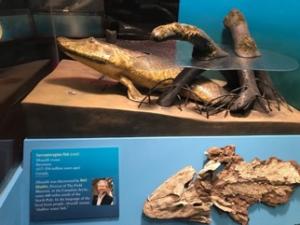I love telling people the story of how, during my bio topic (a biological sciences elective required as part of the Core), I casually googled my professor, David Jablonski, and discovered he had recently received the Paleontological Society’s most prestigious award. I remember thinking that he must be, by far, UChicago’s Coolest Paleontologist™. I have since learned that many other faculty members compete with him for that imaginary award, including Paul Sereno (https://paulsereno.uchicago.edu/) of the famous “Dinosaur Science” class and Neil Shubin, professor of one of my favorite classes I’ve taken: “The 3.5 Billion Year History of the Human Body.”

I became a fan of Prof. Shubin’s when I read Your Inner Fish, a book that traces the evolutionary history of different parts of the human body. This was the essence of our course, as it not only taught us in-depth about the different parts of human anatomy (we began with the skeletal system and moved through the nervous system, olfactory system, etc.), but also traced the evolutionary and developmental history of those systems.
For example, our discussions on the skeletal system taught us about the different types of bones in our body, how they form, and the germ layers they grow from in an embryo. But, my favorite part of it was tracing the evolutionary history of skeletal systems. Did you know there is an approximately-500-million-year old worm (Pikaia) that had the first hints of chordate features? Did you know that the evolution of teeth is a subject of intense scientific debate? There are two theories: “outside-in” and “inside-out.” As their name implies, outside-in postulates that teeth began first as segments of armor on the exterior of animals’ bodies and then migrated into the mouth. The inside-out theory hypothesizes that teeth in fact began in organisms’ mouths and then moved outside of the mouth to form other hard parts.
Our exciting class discussions were coupled with a new app called “Complete Anatomy,” which provided us with perfect 3-D models of the human body and allowed us to learn more, layer by layer, about the different organ systems we studied. With the app, you can not only isolate different organs and structures, but also turn on and off different layers of the body to focus on specific systems.
One of my favorite parts of the class was our term paper. Prof. Shubin is the former provost of the Field Museum, which happens to be one of my absolute favorite places in the city. The (objectively) best exhibit in the natural history museum is called “Evolving Planet.” It traces the development of life from the Big Bang and across Earth’s history, covering every geological epoch and mass extinction. There is a section of the exhibit entirely dedicated to Sue, the Field Museum’s beloved T. rex, and a room with an 8-hour movie on loop that shows animations of different Cambrian Period creatures (which look like aliens!). Our assignment was to go through the exhibit and come up with a way to relate one of the displays to features of human anatomy. I wrote my paper on the evolution of bipedalism in humans, which stemmed from the hominids on display in the exhibit. Walking upright on two legs sets humans apart from other primates. The evolution behind our gait is a subject of debate as fossil evidence shows that different structures related to bipedal walking evolved at different stages in human history. For example, Sahelanthropus tchadensis is an early human ancestor that lived about 7 million years ago. The only fossil evidence we have for this species is a partial skull, however, there are some characteristics of the skull that indicate Sahelanthropus may have been somewhat-suited to bipedal life. But, as another example, the proportions of our inner-ear and the structures in it that help us stay balanced did not evolve until much later, with Homo erectus (which lived about 2 m.y.a-100,000 years ago).
I had been excited about this class since I first heard about it my sophomore year, and it lived up to and exceeded all of my expectations! I gained a new understanding of human anatomy and the ways our body works. I also received valuable knowledge about the evolutionary mechanisms that led humans to be the way that we are, the history of important discoveries, how humans develop from an embryo to an adult, and the funny ways we can trace our development (our professor joked that he always saw humans as having an “inner fish” as many of our structures are similar). This class had no prerequisites, so it was a great way for some to fulfill their Biological Sciences Core requirement, or for others (like me) with totally-unrelated majors to explore their anatomy/evolution interests!